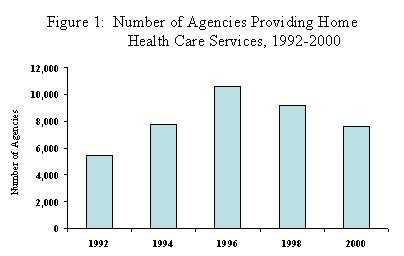Home Health Care Patients: Data from the 2000 National Home and Hospice Care Survey
For Release: March, 2004
Contact: NCHS/CDC Public Affairs, (301) 458-4800
E-mail: paoquery@cdc.gov
National Home and Hospice Care Data
New data tables from the 2000 National Home and Hospice Care Survey are now available, detailing the latest findings from this increasingly important segment of health care in America. The 2000 National Home and Hospice Care Survey (NHHCS), the sixth in a series of surveys (conducted in 1992, 1993, 1994, 1996, 1998, and 2000), provides information on characteristics of agencies providing home health and hospice care services, their current patients, and discharges. This fact sheet provides highlights from the 2000 NHHCS.
Data Highlights
- 70 percent of home health care patients were ages 65 and older.
- Medicare was the primary payment source for most home care patients (52 percent), followed by Medicaid (20 percent) and private sources (17 percent).
- Heart disease (11 percent), diabetes (8 percent), cerebral vascular disease (7 percent), COPD (5 percent), malignant neoplasms (5 percent), congestive heart failure (4 percent), osteoarthritis and allied disorders (4 percent), fractures (4 percent), and hypertension (3 percent) are among the most prevalent admission diagnoses for home health care patients.
- Most patients received medical/skilled nursing services (75 percent), followed by personal care (44 percent) and therapeutic (37 percent) services.
- Over half of home care patients received help from the agency with at least one activity of daily living (ADL) (51 percent); of those patients receiving help with ADLs, 83 percent received help with bathing or showering.
- Average length of service since admission was 312 days; patients with an admission diagnosis of pneumonia had the shortest length of service (111 days), whereas patients with essential hypertension had the length of service (515 days).
Approximately 1,355,300 patients were receiving home health care services from 7,200 agencies at the time of the 2000 NHHCS. Figures 1 and 2 show the initial growth and recent declines in the number of agencies providing home health care and the number of patients receiving these services. The number of agencies peaked in 1996, but between 1996 and 2000 the number declined by 30 percent. The number of patients almost doubled between 1992 and 1996 as well, but by 2000 the number of patients decreased to levels similar to 1992. Between 1990 and 1996, home health care was the fastest growing segment of the health care industry with expenditures for these services more than doubling, increasing from $13 to $30 billion.⊃1; During the mid 1990’s concerns about inappropriate and fraudulent use and the rapidly growing aging population spurred the Centers for Medicare and Medicaid Services (CMS), the major funding source for home health care, to implement major cost-containment strategies to curtail escalating Medicare costs.⊃2;


Data Availability
Tables as well as data files from the 2000 NHHCS can be viewed and down loaded from the National Home and Hospice Care Data Web Site. The new data tables present characteristics of agencies providing home health and hospice care and the patients they serve. The tables are organized by type of care received, home health or hospice, and type of patient, current patient or discharge. Home care and hospice care definitions are provided for easy reference. New information on median length of stay, type of services received (medical/skilled nursing, equipment and/or supplies, personal care, therapeutic, and psychosocial), and types of aids and devices used by patients (sensory and/or dental, mobility, self-care, and medical) are presented.
Patients and discharges are examined by selected agency and patient characteristics.
Agency characteristics include:- type of ownership
- region
- certification
- location
- affiliation
Patient characteristics include:
- basic demographic information
- primary expected source of payment
- current residence
- living arrangements
- caregiver status
- services received
- functional status
- aid and devices used
- length of service (mean and median)
- primary diagnosis.
The tables provide the numbers of patients or discharges by sex, race, and various age groups (under 18, 18-44, 45-64, 65-74, 75-84, and 85 years and older). Median and mean length of service are also provided for selected agency and patient characteristics.
References
- National Health Care Expenditures Projections: 2002-2012. Accessed March 19, 2004.
- McCall N, Korb J, Petersons A, Moore S. (2003) Reforming Medicare payment: Early Effects of the 1997 Balanced Budget Act on postacute care. The Milbank Quarterly. 18(2):277-303.
- Page last reviewed: August 10, 2009
- Page last updated: January 6, 2010
- Content source:


 ShareCompartir
ShareCompartir